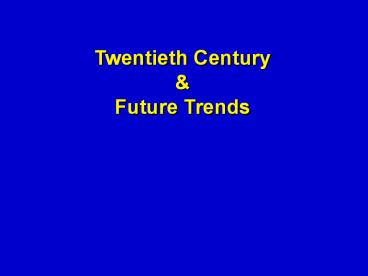Twentieth Century - PowerPoint PPT Presentation
Title:
Twentieth Century
Description:
(IPCC TAR) Performance of GCMs - Control Climates Note: ... 2040s - 1990s Emission Scenarios: Special Report on Emission Scenarios (SRES) A1 ... – PowerPoint PPT presentation
Number of Views:129
Avg rating:3.0/5.0
Title: Twentieth Century
1
Twentieth Century Future Trends
2
N.H. Surface Air Temperature
(IPCC TAR)
3
Surface Air Temperature
(IPCC TAR)
4
Surface Air Temperature
(IPCC TAR)
5
Trends in Temperature
(IPCC TAR)
6
Trends in Temperature
(IPCC TAR)
7
Trends in Temperature
(IPCC TAR)
8
Seasonal Temperature Trends
(IPCC TAR)
9
Trends in Diurnal Temperature Range
- 1950-1993
- Non-urban stations only
(IPCC TAR)
10
Diurnal Temperature Range vs. Cloud Cover
- cloud cover - solid
- DTR (C) - dashed
(IPCC TAR)
11
Lower Troposphere Trends
(IPCC TAR)
12
Lower Stratosphere Trends
(IPCC TAR)
13
Glacier Retreat
(IPCC TAR)
14
N.H. Snow Cover Extent
(IPCC TAR)
15
N.H. Sea Ice Extent
(IPCC TAR)
16
S.H. Sea Ice Extent
(IPCC TAR)
17
Arctic Sea Ice Thickness
(IPCC TAR)
18
Precipitation Trends
(IPCC TAR)
19
Precipitation Trends
(IPCC TAR)
20
Surface Vapor Pressure Change
(IPCC TAR)
(1975 - 1995)
21
Changes in Extremes
(IPCC TAR)
22
Change in Precipitation
(Heavy above 90th percentile periods gt 50
yr.)
(IPCC TAR)
23
Change in Annual Max5-d Prec.
(period 1946 - 1999)
(IPCC TAR)
24
Change in Annual Max5-d Prec.
(period 1946 - 1999)
(IPCC TAR)
25
Changes in Hurricanes
U.S. Landfall Hurricanes
Category 3-5 in North Atlantic
(IPCC TAR)
26
Changes in Tornadoes
(IPCC TAR)
Reported F3-F5 Tornadoes in U.S. (Dashed line
based on storm damage reports)
27
(IPCC TAR)
28
(IPCC TAR)
29
NH Reconstructed T vs. Candidate Forcings
NH Temperature
Solar
Log(CO2)
Correlation of 200-yr running average NH
temperature vs. forcings
Dust Veil Index
(Mann et al. 1998)
30
Performance of GCMs - Control Climates
(IPCC TAR)
31
Performance of GCMs - Control Climates
Note 50 of earths surface is between 30
latitude
(IPCC TAR)
32
Performance of GCMs - Control Climates
(IPCC TAR)
33
Performance of GCMs - Control Climates
(IPCC TAR)
34
Performance of GCMs - Control Climates
Note 50 of earths surface is between 30
latitude
(IPCC TAR)
35
Performance of GCMs - Control Climates
(0.5 ? 50 of 15 models give ice at location)
(IPCC TAR)
36
Natural Variability vs. Obs. Variability
GCMs with no forcing changes
Observed
(IPCC TAR)
37
Global Model T vs. Obs. T
Ensemble of GCMs with solar and volcanic forcing
changes
(IPCC TAR)
38
Global Model T vs. Obs. T
Ensemble of GCMs with GHG, O3 and aerosol forcing
changes
(IPCC TAR)
39
Global Model T vs. Obs. T
Ensemble of GCMs with natural and anthropogenic
forcing changes
(IPCC TAR)
40
Spatial Distribution of T Trends
(IPCC TAR)
41
Spatial Distribution of T Trends
Ensemble mean of 5 GCMs (R30 resolution)
(IPCC TAR)
42
Spatial Distribution of T Trends
Grey Observed trends within the natural
variability of the R30 GCM
(IPCC TAR)
43
Spatial Distribution of T Trends
Grey Observed trends within the natural
variability of the R30 GCM
(IPCC TAR)
44
Change in Daily maxT for June-July-August (RegCM
2 simulation 2040s - 1990s)
C
Pan et al. (2004)
45
Change in Daily maxT (RegCM2 simulation 2040s
- 1990s)
Pan et al. (2004)
46
Change in LLJ Frequency
Change in Soil Moisture mm
RegCM2 simulation 2040s - 1990s
Pan et al. (2004)
47
Changes in Precipitation, Evaporation, Sensible
Heat Flux
RegCM2 simulation 2040s - 1990s
Pan et al. (2004)
48
Emission Scenarios Special Report on Emission
Scenarios (SRES)
A1 - Very rapid economic growth global
population peaks 2050 rapid introduction of
new, efficient technologies substantial
reduction of social/econ. differences A2 - Very
heterogeneous world continuously increasing
population fragmented introduction of new
technologies B1 - Very rapid economic growth
global population peaks 2050 transition to
service/information-based economy clean,
resource-efficient technologies B2 - Very
heterogeneous world continuously increasing
population (lower than A2) fragmented
introduction of new technologies oriented toward
environmental protection and social equity (Also
- IS92 scenarios - older)
49
Global T Change A2 B2
(IPCC TAR)
50
Global Precip. Change A2 B2
(IPCC TAR)
51
Temperature Change (2071-2100) minus (1961-1990)
Multi-model ave. ?T (colors), range (blue), ave.
?T/SDEV (green)
(IPCC TAR)
52
Temperature Change (2071-2100) minus (1961-1990)
Multi-model ave. ?T (colors), range (blue), ave.
?T/SDEV (green)
(IPCC TAR)
53
Precipitation Change (2071-2100) minus
(1961-1990)
Multi-model ave. ?P (colors), range (red), ave.
?P/SDEV (green)
(IPCC TAR)
54
Precipitation Change (2071-2100) minus
(1961-1990)
Multi-model ave. ?P (colors), range (red), ave.
?P/SDEV (green)
(IPCC TAR)
55
(IPCC TAR)
56
(IPCC TAR)
57
Twentieth Century Future Trends END













![READ⚡[PDF]✔ The Names of John Gergen: Immigrant Identities in Early Twentieth-Century St. PowerPoint PPT Presentation](https://s3.amazonaws.com/images.powershow.com/10051220.th0.jpg?_=20240608118)


![[READ]⚡PDF✔ Contending With Modernity: Catholic Higher Education in the Twentieth Century 1st E PowerPoint PPT Presentation](https://s3.amazonaws.com/images.powershow.com/10061494.th0.jpg?_=202406211112)





![[READ DOWNLOAD] The Modern Mind: An Intellectual History of the 20th Century PowerPoint PPT Presentation](https://s3.amazonaws.com/images.powershow.com/10107577.th0.jpg?_=20240824105)

![[READ DOWNLOAD] The Modern Mind: An Intellectual History of the 20th Century PowerPoint PPT Presentation](https://s3.amazonaws.com/images.powershow.com/10108913.th0.jpg?_=20240825066)
![[READ DOWNLOAD] The Modern Mind: An Intellectual History of the 20th Century PowerPoint PPT Presentation](https://s3.amazonaws.com/images.powershow.com/10110315.th0.jpg?_=202408260512)





![[READ DOWNLOAD] The Modern Mind: An Intellectual History of the 20th Century PowerPoint PPT Presentation](https://s3.amazonaws.com/images.powershow.com/10134739.th0.jpg?_=20240921024)